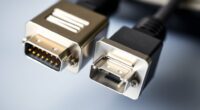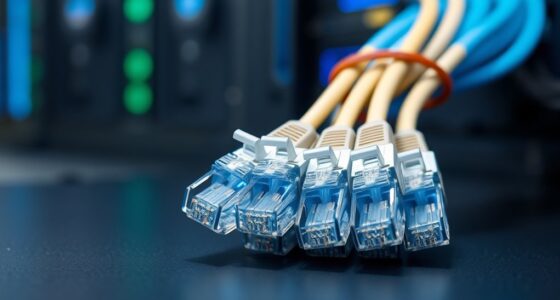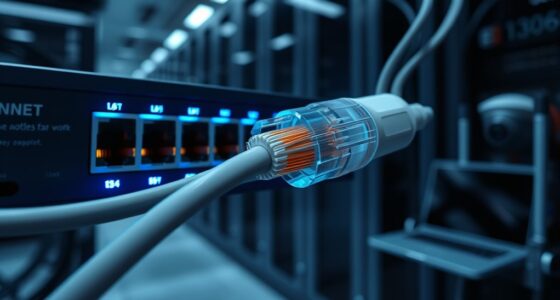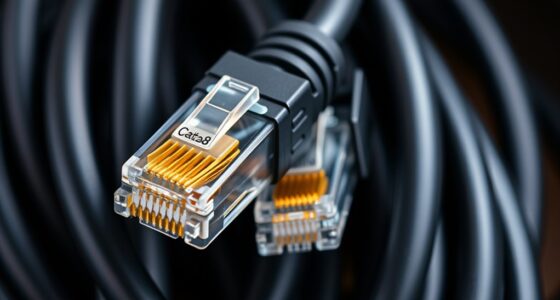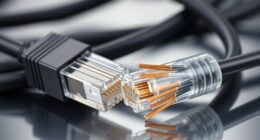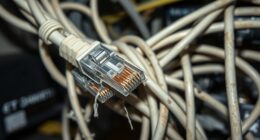When working with fiber optic networks, alien crosstalk can unexpectedly disrupt your signals and compromise data integrity. It often happens when external electromagnetic interference or poor cable shielding causes signals to bleed between fibers. Understanding what leads to this interference and how to prevent it is vital for maintaining reliable, high-speed communication. Exploring the causes and solutions can help you safeguard your network against these subtle but impactful issues.
Key Takeaways
- Alien crosstalk occurs when signals leak between fiber optic channels or are induced by external electromagnetic interference.
- Causes include poor shielding, proximity to EMI sources, microbends, and physical imperfections in fiber cables.
- Proper installation practices, such as maintaining distance from EMI sources and using shielded cables, reduce crosstalk risk.
- Grounding, high-quality connectors, and conduit installation help prevent external electromagnetic coupling into fibers.
- Regular testing and monitoring are essential for early detection and mitigation of alien crosstalk issues.
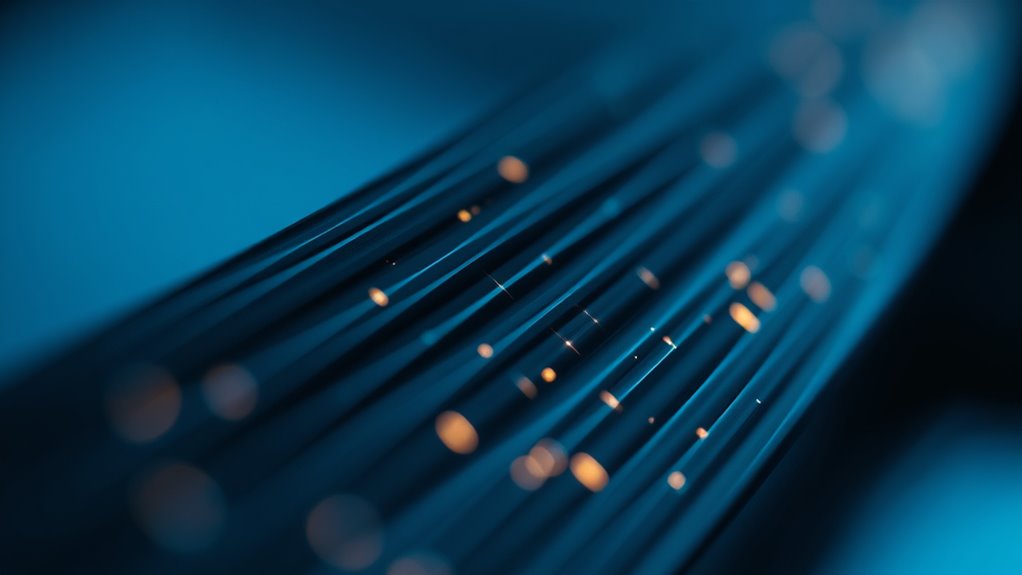
Alien crosstalk occurs when signals from different communication channels interfere with each other, leading to data corruption or loss. This phenomenon is especially problematic in high-speed data transmission systems, such as those using fiber optics. Fiber optic cables are designed to carry signals with minimal loss, but they can still be susceptible to external influences. One common cause of alien crosstalk in fiber optics is electromagnetic interference (EMI). EMI occurs when electromagnetic fields from nearby electrical devices or radio frequency sources induce unwanted signals into the fiber, disrupting the intended data transmission.
Alien crosstalk disrupts fiber optic signals through electromagnetic interference, risking data integrity in high-speed systems.
Unlike electrical cables, fiber optics are immune to many forms of electromagnetic interference, but they aren’t entirely immune. External electromagnetic fields can induce noise in the optical fibers, especially if the cables are poorly shielded or run close to sources of strong electromagnetic fields like transformers, motors, or radio antennas. This interference can couple into the fiber via microbends or imperfections, creating signals that appear as crosstalk. When multiple fiber optic channels are bundled together in a single cable, the risk of alien crosstalk increases, as signals from one fiber can leak into neighboring fibers, especially if the cable isn’t properly insulated or shielded.
Preventing alien crosstalk involves both proper installation and the use of shielding techniques. When deploying fiber optic cables, you should keep them away from sources of electromagnetic interference whenever possible. Using shielded cables or installing the fibers within conduits that block electromagnetic fields can considerably reduce the risk. Additionally, ensuring the cables are well-maintained and free from microbends or physical damage helps minimize susceptibility to external interference. Proper grounding of the entire communication system can also help dissipate any induced electromagnetic energy before it causes damage or data corruption.
Another effective measure is to use high-quality fiber optic connectors and splicing techniques that ensure minimal leakage of signals. Regular testing and monitoring of the fiber optic infrastructure can help detect early signs of alien crosstalk, allowing you to address issues before they impact data transmission. Employing optical isolators or filters in the system can further diminish the impact of external electromagnetic interference, reducing the chances of alien crosstalk. Additionally, understanding the amplitude of electromagnetic fields in the environment can help in planning more effective shielding strategies to prevent interference.
Frequently Asked Questions
How Does Alien Crosstalk Differ From Normal Crosstalk?
You notice alien crosstalk differs from normal crosstalk because it involves interdimensional interference, making it more unpredictable and harder to troubleshoot. Instead of typical electrical noise, you might detect extraterrestrial signals that seem to originate from beyond our dimension. Normal crosstalk usually results from close cable proximity, but alien crosstalk involves complex, external influences that require specialized detection and prevention methods.
What Are the Long-Term Effects of Alien Crosstalk?
You might notice that alien crosstalk causes ongoing disruptions, like static in your mind’s eye, leading to biological impacts such as stress and fatigue. Over time, these effects can weaken your focus and impair communication systems. To combat this, you’ll need technological adaptations that filter out interference, ensuring your signals remain clear and health stays intact, preventing long-term damage from persistent, unseen interference.
Can Alien Crosstalk Occur in Wireless Networks?
Yes, alien crosstalk can occur in wireless networks. It happens when signals from nearby devices interfere, causing degraded performance. To prevent this, you should focus on interference mitigation techniques like proper channel selection and reducing device proximity. Ensuring effective signal isolation through shielding or directional antennas helps minimize alien crosstalk. By managing these factors, you can enhance your wireless network’s reliability and reduce unwanted interference.
Are There Specific Frequencies More Prone to Alien Crosstalk?
You might notice certain frequencies are more prone to alien crosstalk, especially those with high frequency susceptibility. These bands, often within the microwave or millimeter-wave ranges, can create interference patterns that mysteriously overlap and disrupt signals. As you monitor your network, stay alert for these vulnerable frequencies, because understanding their behavior helps you identify potential crosstalk sources and take steps to minimize their disruptive influence.
How Does Temperature Influence Alien Crosstalk Levels?
Temperature fluctuations can increase alien crosstalk levels by causing expansion and contraction of cables, which may disrupt shielding and insulation. Poor thermal insulation allows rapid temperature changes, making signals more prone to interference. When cables aren’t properly insulated or stabilized, crosstalk worsens, especially in environments with inconsistent temperatures. To minimize this, guarantee good thermal insulation and proper cable management, reducing the impact of temperature changes on crosstalk performance.
Conclusion
Think of your fiber optic cables like a quiet neighborhood. When you keep them far from noisy sources like transformers and use shielded cables, you guarantee clear, uninterrupted communication. I once saw a technician install a cable near a radio tower, and data kept dropping—like static on a radio. Proper grounding and careful installation act as fences and soundproofing, keeping unwanted interference out. With these precautions, your network stays reliable, just like a peaceful, well-maintained neighborhood.

